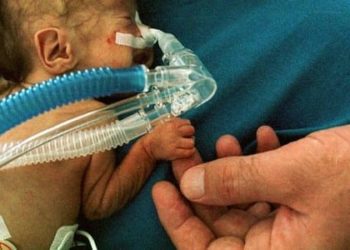Phthalate exposure during pregnancy associated with preterm birth
Image: PD
1. Preterm delivery was associated with dose-dependent, higher urinary phthalate metabolites during pregnancy.
2. The magnitude of this association was greatest among spontaneous preterm deliveries.
Evidence Rating Level: 2 (Good)
Study Rundown: This study found that preterm birth was associated with higher urinary levels of four phthalate metabolites, a manmade chemical widely used in plastics. When stratified by type of preterm delivery, spontaneous deliveries (precipitated by preterm labor or premature rupture of membranes) had a greater magnitude of association compared with all preterm deliveries.
Phthalate levels were measured at multiple times during pregnancy, allowing for a better surrogate for overall pregnancy exposure. Additional strengths include large sample size that allowed for comparisons between types of preterm delivery. Limitations include lack of accounting for differences in diet as well as differences in metabolism and excretion of phthalates, both of which could confound the observed association. Future studies might assess pthalate exposure not only through urine but also through food diaries, or even by testing submitted food samples, and might also assess renal function to further characterize the observed associations.
Click to read the study in JAMA Pediatrics
Click to read an accompanying editorial in JAMA Pediatrics
Relevant Reading: Environmental Chemicals in Pregnant Women in the United States: NHANES 2003–2004
In-Depth [case-control study]: Researchers compared levels of nine urinary phthalate metabolites in pregnancy among 130 preterm (<37 wks gestation) deliveries and 352 randomly selected full-term control deliveries. In a subset of deliveries for which indication for preterm delivery was known (n=57), deliveries were stratified by type of delivery: spontaneous (i.e. spontaneous preterm labor or preterm premature rupture of membranes) or medically indicated preterm delivery (n=57).
Compared with controls, women who delivered preterm were more likely to have elevated urinary levels of 3 phthalate metabolites in pregnancy (MEHP: OR=1.35, p=0.01; MECPP: OR=1.40, p=0.002; DEHP: OR=1.33, p=0.02). The magnitude of these associations was greatest among spontaneous preterm deliveries. Relationship appeared dose-dependent when broken down into quartiles of urinary pthalate levels (MEHP Ptrend=0.01; MECCP Ptrend=0.003; DEHP Ptrend=0.02).
By Maren Shapiro and Leah Hawkins, MD, MPH
More from this author: IUD contraception equally safe in teenagers as in older women, Black men less likely to receive follow-up for elevated prostate cancer marker, PSA, Intake of fish fatty acids associated with lower risk of breast cancer, USPSTF recommends chemoprevention for women at high risk for breast cancer, Insurance status affects treatment of early stage breast cancer, SERMs decrease breast cancer risk even after treatment
©2012-2013 2minutemedicine.com. All rights reserved. No works may be reproduced without expressed written consent from 2minutemedicine.com. Disclaimer: We present factual information directly from peer reviewed medical journals. No post should be construed as medical advice and is not intended as such by the authors, editors, staff or by 2minutemedicine.com. PLEASE SEE A HEALTHCARE PROVIDER IN YOUR AREA IF YOU SEEK MEDICAL ADVICE OF ANY SORT.









